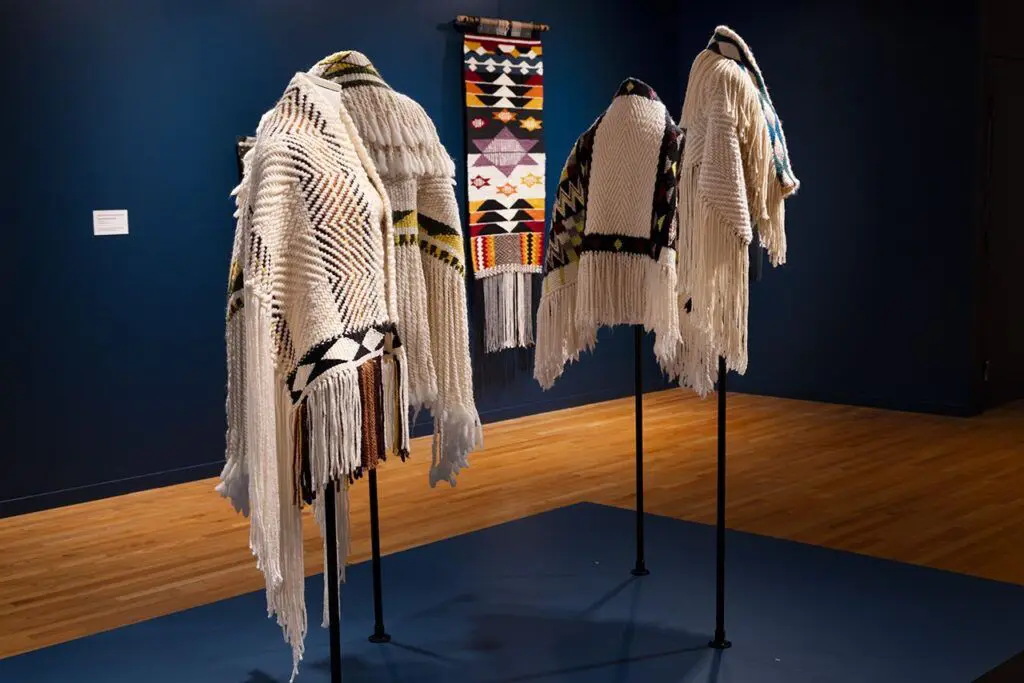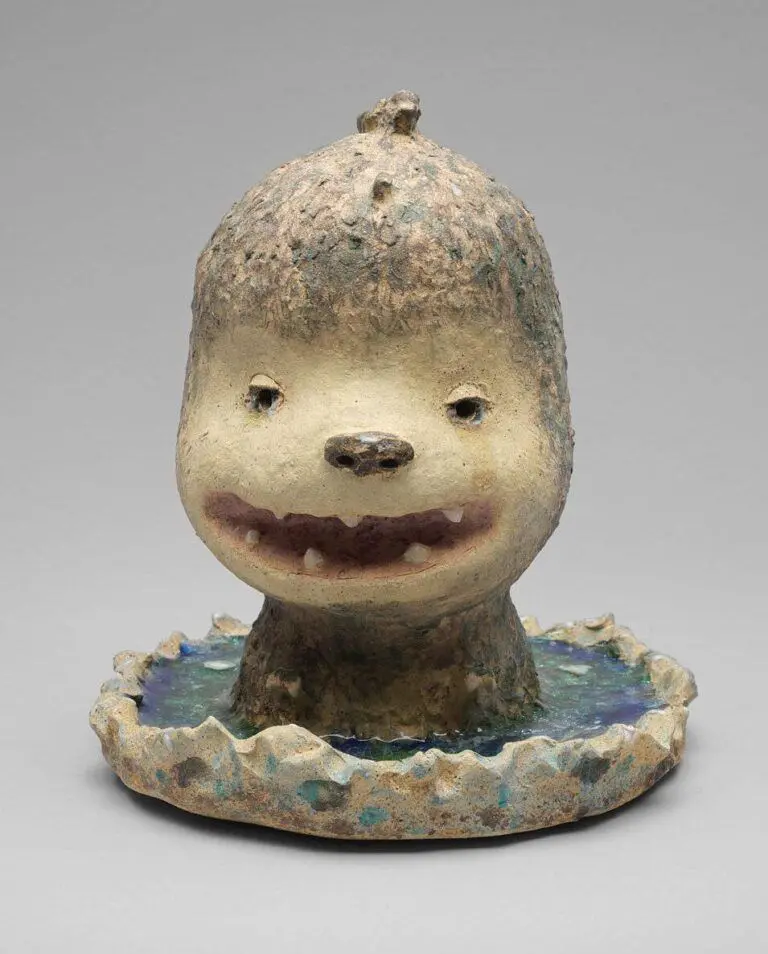Panel Conversation:
Rooted Here: Woven from the Land
Thu Apr 25, 2024 | 5:30–7 PM

Installation view of Rooted Here: Woven From the Land, exhibition at the Vancouver Art Gallery from December 16, 2023 to May 12, 2024, Photo: Vancouver Art Gallery
This event has now reached capacity. Thank you for your interest, and we hope to welcome you to the Gallery again soon. If you have a ticket but can no longer attend, please email us at learn@vanartgallery.bc.ca to release your ticket.
Please join us for a panel conversation that will bring together four prominent local Salish weavers featured in the exhibition Rooted Here: Woven From the Land: qʷənat, Angela George (səlilwətaɬ/Tsleil-Waututh); Chepximiya Siyam’ Chief Janice George (Sḵwx̱wú7mesh/Squamish); Skwetsimeltxw Willard “Buddy” Joseph (Sḵwx̱wú7mesh/Squamish); and Qwasen, Debra Sparrow (xʷməθkʷəy̓əm/Musqueam).
This discussion will expand upon the shared histories of Salish communities and kin, while also delving into important contexts for understanding each artist’s work, including the long history of Salish weaving, the rootedness of these traditions in the land and its resources, the interruption of Salish weaving by colonialism and the artists’ significant roles in its contemporary revival and renewal for generations to come. It will also create an opportunity to better understand the crucial role these artists have played in designing the Vancouver Art Gallery’s new building and the rich significance of its woven surface.
This event is free and open to the public. Registration is required.
ABOUT THE SPEAKERS
qʷənat, Angela George lives and works in the səlilwətaɬ (Tsleil-Waututh) Nation in North Vancouver. She has a passion for traditional canoe racing, weaving and cultural singing and dancing. George has dedicated her career to the betterment of First Nations people and communities. Well versed in traditional teachings, George has a strong understanding of her culture, spiritual teachings and the impacts of colonization and barriers that plague First Nations communities. She believes that practicing traditions, having a strong sense of identity and connection to ancestry is vital to community wellness, development and sustainability. George completed the Master of Business Administration program at Simon Fraser University, with a final capstone project called “Weaving Governance,” highlighting Tsleil-Waututh traditional law and governance. She is humbled by the gift of traditional weaving, holding this connection to her late mother, Cookie Thomas, from Swxwú7mesh, and Squamish ancestry dearly. She loves to learn and teach weaving and strives to carry this sacred practice with the utmost integrity.
Chief Janice George of the Squamish Nation is a master weaver and textile artist. Her ancestral name is Chepximiya Siyam, and she comes from a prominent Squamish family. As a hereditary chief, she participates in numerous ceremonial and cultural responsibilities in her community. Chief George learned to weave from Coast Salish weaver Susan Pavel and Subiyay-t Bruce Miller of Skokomish in 2003. She integrates Squamish teachings passed down from her late grandmother Kwitelut-t Lena Jacobs and other Squamish ancestors into her work. Chief George co-founded the L’hen Awtxw Weaving House with her husband and fellow weaver, Skwetsimeltxw Willard “Buddy” Joseph, to share the teachings and practice of traditional Coast Salish wool weaving. She has visited many museums that house Salish blankets in their collections and has spent countless hours analyzing them and developing resources that have helped to revive Salish weaving. Chief George views her contributions to the perpetuation of weaving as a responsibility and is passionate about reclaiming the art. Chief George graduated from Capilano University in North Vancouver, BC, and the Institute of American Indian Arts in Santa Fe, New Mexico. She has also interned at the Canadian Museum of History in Gatineau, Quebec. She co-authored the book, Salish Blankets: Robes of Protection and Transformation, Symbols of Wealth.
Willard “Buddy” Joseph is an artist, master weaver and educator, who grew up on Squamish Nation lands. His traditional ancestral name is Skwetsimeltxw. He is the former Director of Housing and Capital Projects for the Squamish Nation. Joseph co-authored the book Salish Blankets: Robes of Protection and Transformation, Symbols of Wealth and co-founded the L’hen Awtxw Weaving House to share the teachings and practice of traditional Coast Salish wool weaving. He also co-founded the M̓i tel’nexw Leadership Transformation, an online seminar to share teachings of Indigenous resilience. Joseph has played an important role in the revival of Coast Salish weaving, learning Coast Salish weaving techniques from Susan Pavel and Elder Subiyay-t Bruce Miller of the Skokomish Nation in Washington State in 2003. He is also the first Elder in Residence at the Vancouver Art Gallery.
Debra Sparrow is a Musqueam weaver, artist and knowledge keeper. Her ancestral name is Qwasen. She is self-taught in Salish design, weaving and jewellery making. Her contemporary work combines textile and Salish design, and she creates geometric, hand-spun blankets and wall hangings. Sparrow was born and raised on the Musqueam Indian Reserve, and she credits her grandfather, Ed Sparrow—who lived to be 100 years old and remembered the forcible removal of the Musqueam people from Stanley Park—with giving her 300 years of stories that have grounded her in her heritage and enabled her to hear the voices of her ancestors. When Sparrow was a child, the techniques of Salish weaving were lost to the Musqueam Nation. There were no living weavers to teach a new generation; the last known weaver before the revival was her great-grandmother. Sparrow attended a weaving course at the Vancouver Indian Centre (now the Vancouver Aboriginal Friendship Centre) in 1986, and then co-founded a group of women weavers in the 1980s, who rejuvenated the Salish weaving tradition. They were able to reconstruct the lost weaving techniques through books by examining blankets handed down in their families and by doing research in museums. Sparrow’s work can be found in the collections of the Burke Museum, the Canadian Museum of History, the Heard Museum and the Royal British Columbia Museum. In 2017, Sparrow participated in the exhibition The Fabric of Our Land: Salish Weaving at the UBC Museum of Anthropology, which brought together some of the oldest Salish weavings in existence from collections around the world. Sparrow’s weaving highlights the knowledge, skills and aesthetic forms of her ancestors and returns them to her community.


